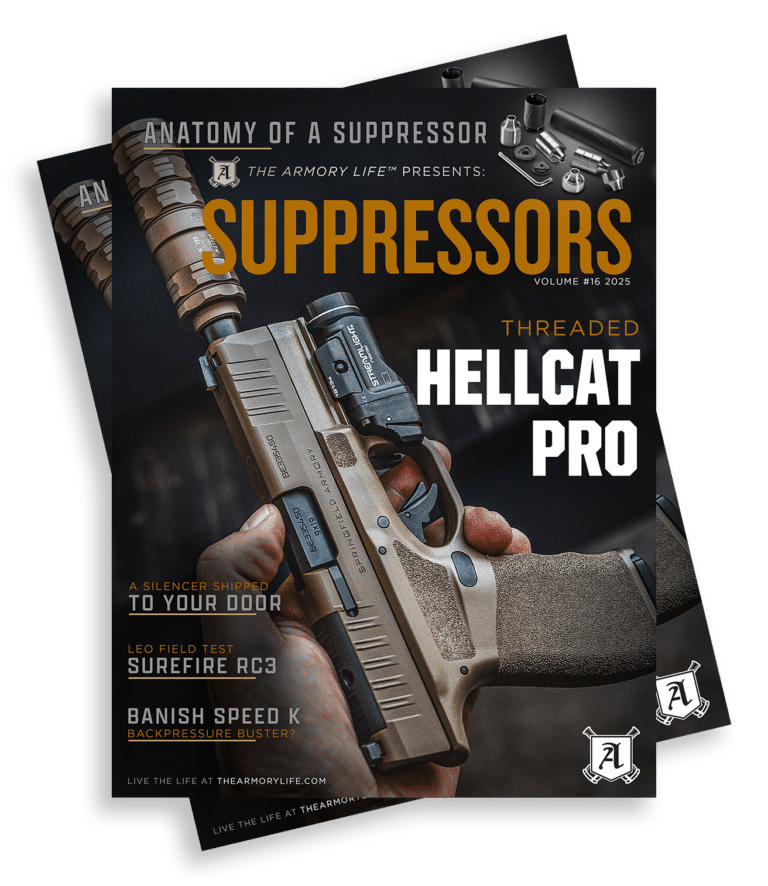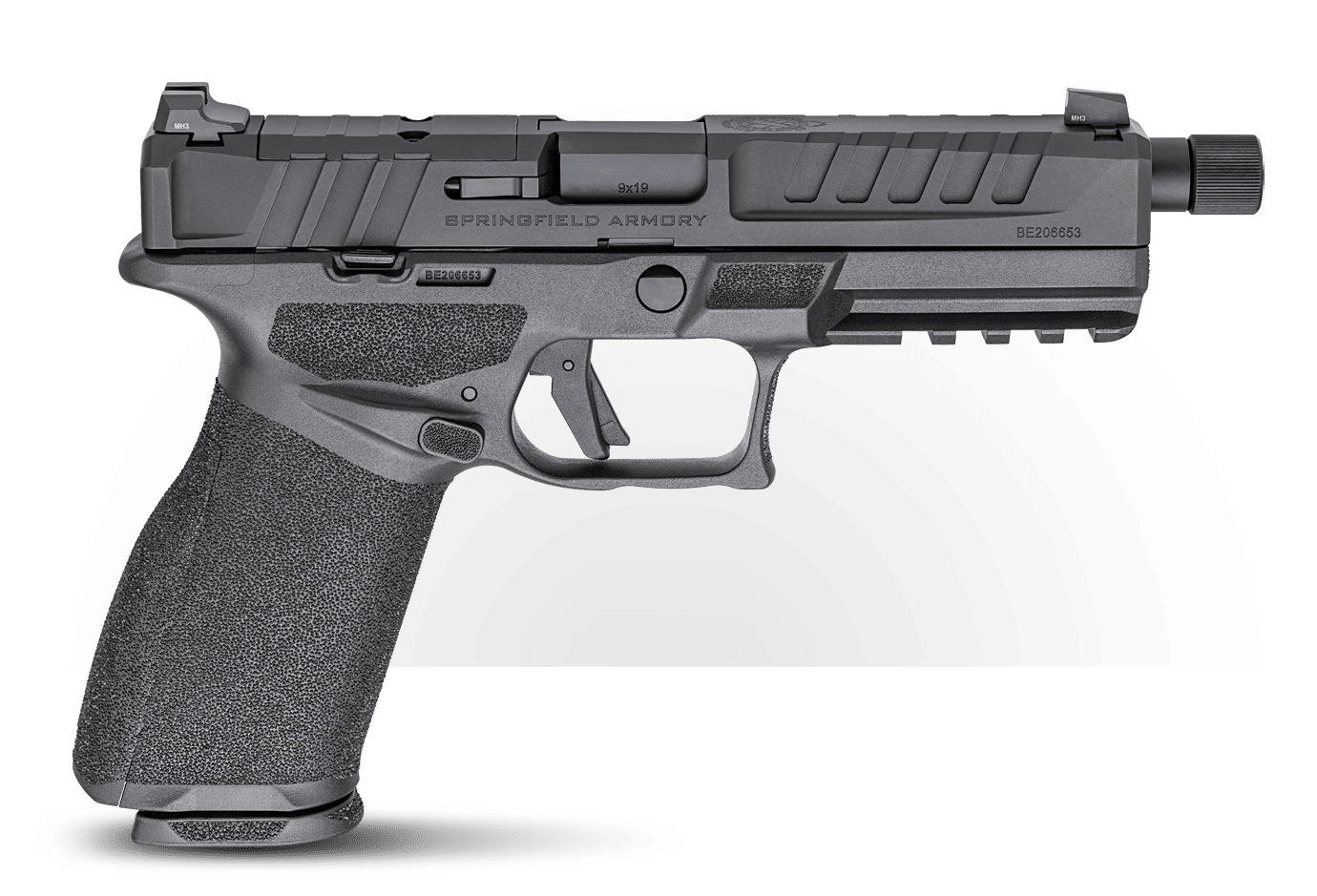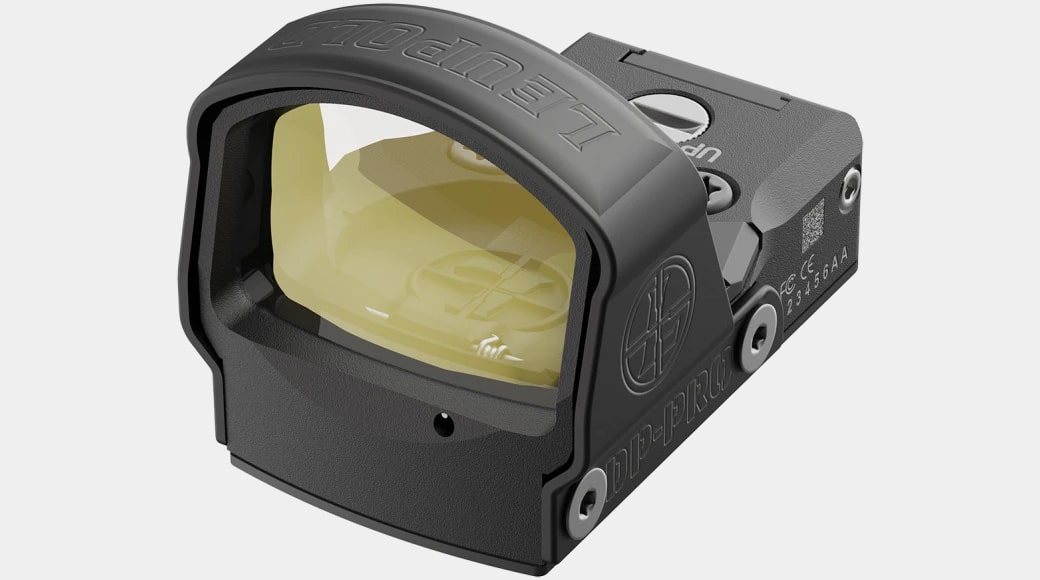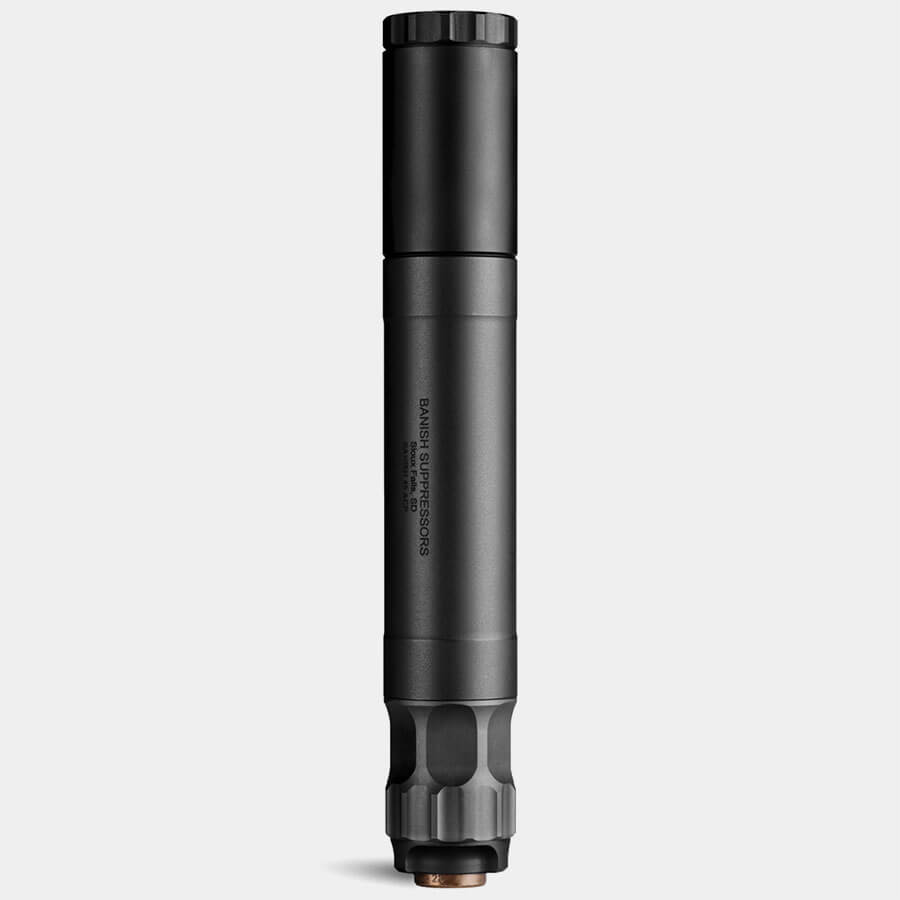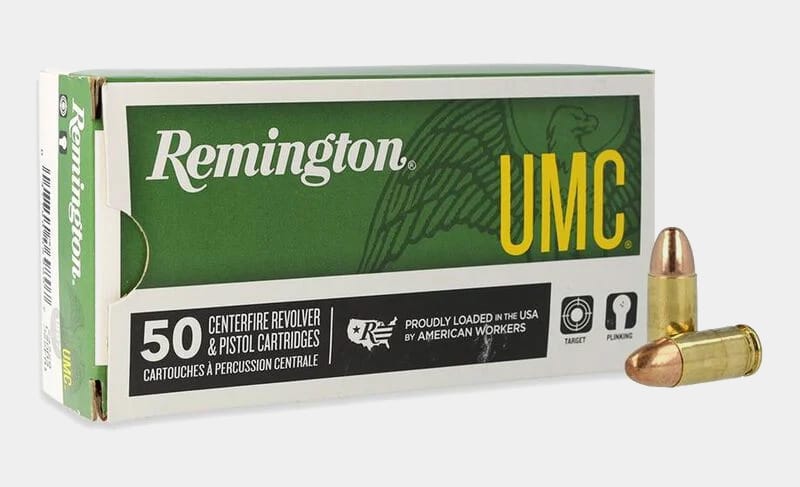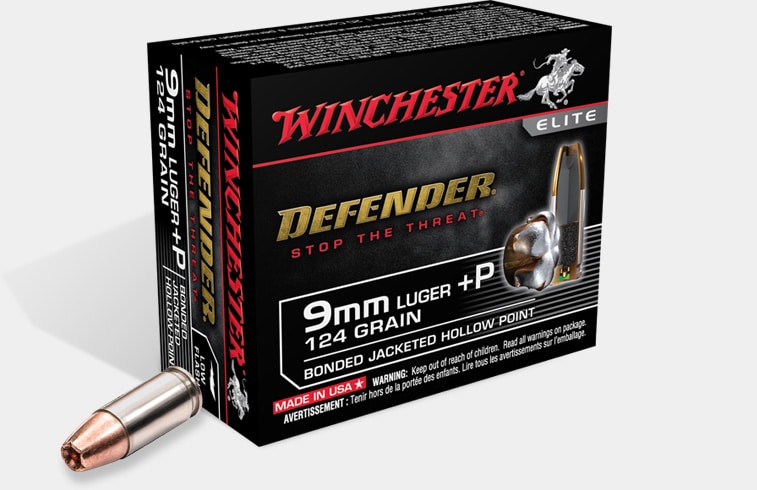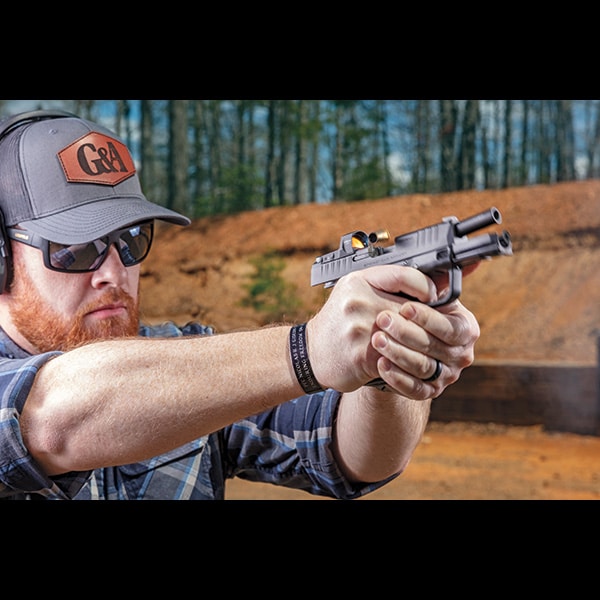Review: Threaded Barrel Echelon
April 3rd, 2024
9 minute read
It’s not easy to stand out in the market for polymer-frame, full-size semi-automatic handguns these days. In 2019, the industry got a taste of things to come from Springfield Armory with the high-capacity, micro-compact Hellcat. Despite its diminutive size, the Hellcat offered 11+1 magazine capacity and was available at launch with a direct-mount Optical Sight Pistol (OSP) system.
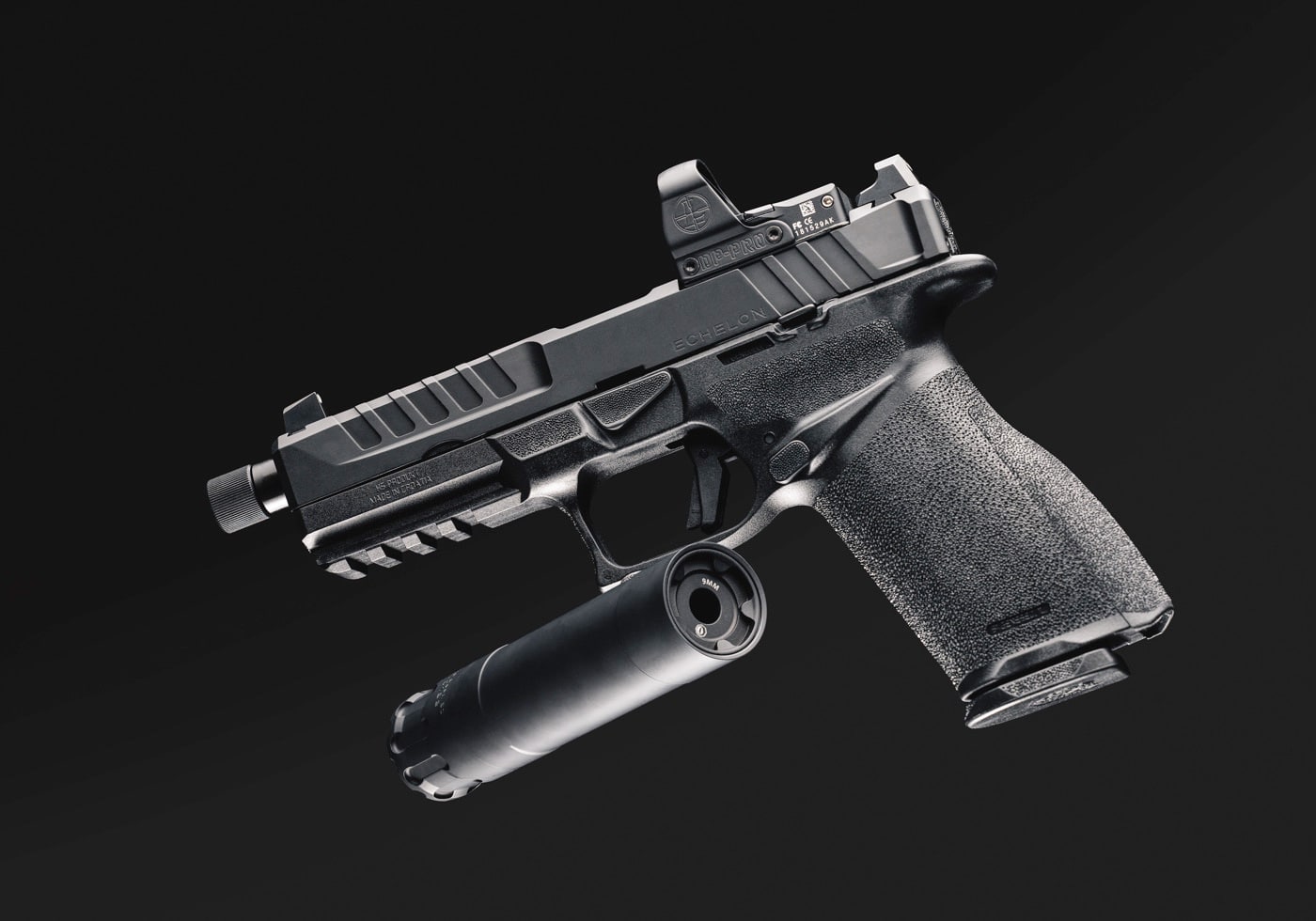
But what does a pint-size pistol like the Hellcat have to do with full-size service sidearms? The Hellcat was the first striker-fired pistol that Springfield Armory designed, from the start, to both take advantage of slide-mounted optics as well as enhanced-capacity magazines. The full-size Echelon was the second.
Enhanced Duty Pistol
Ideal for professional use, home defense and even concealed carry, polymer-framed, striker-fired designs dominate the category of duty pistols thanks to their simple operation, reliability and durable construction. It doesn’t hurt that they are generally more affordable than all-metal guns, either.
[Be sure to also read Massad Ayoob’s Springfield Echelon review.]
Now, though, many of the best-known competitors in the duty-pistol category are getting long in the tooth and have struggled to adapt to the demand for slide-mounted optics. That’s why when I’m asked about the Echelon and how it stacks up against the field, I immediately point to the Variable Interface System, Springfield’s innovative and adaptable approach to slide-mounted optics. Mark my words: The Echelon has effectively freed us from optic-mounting plates.
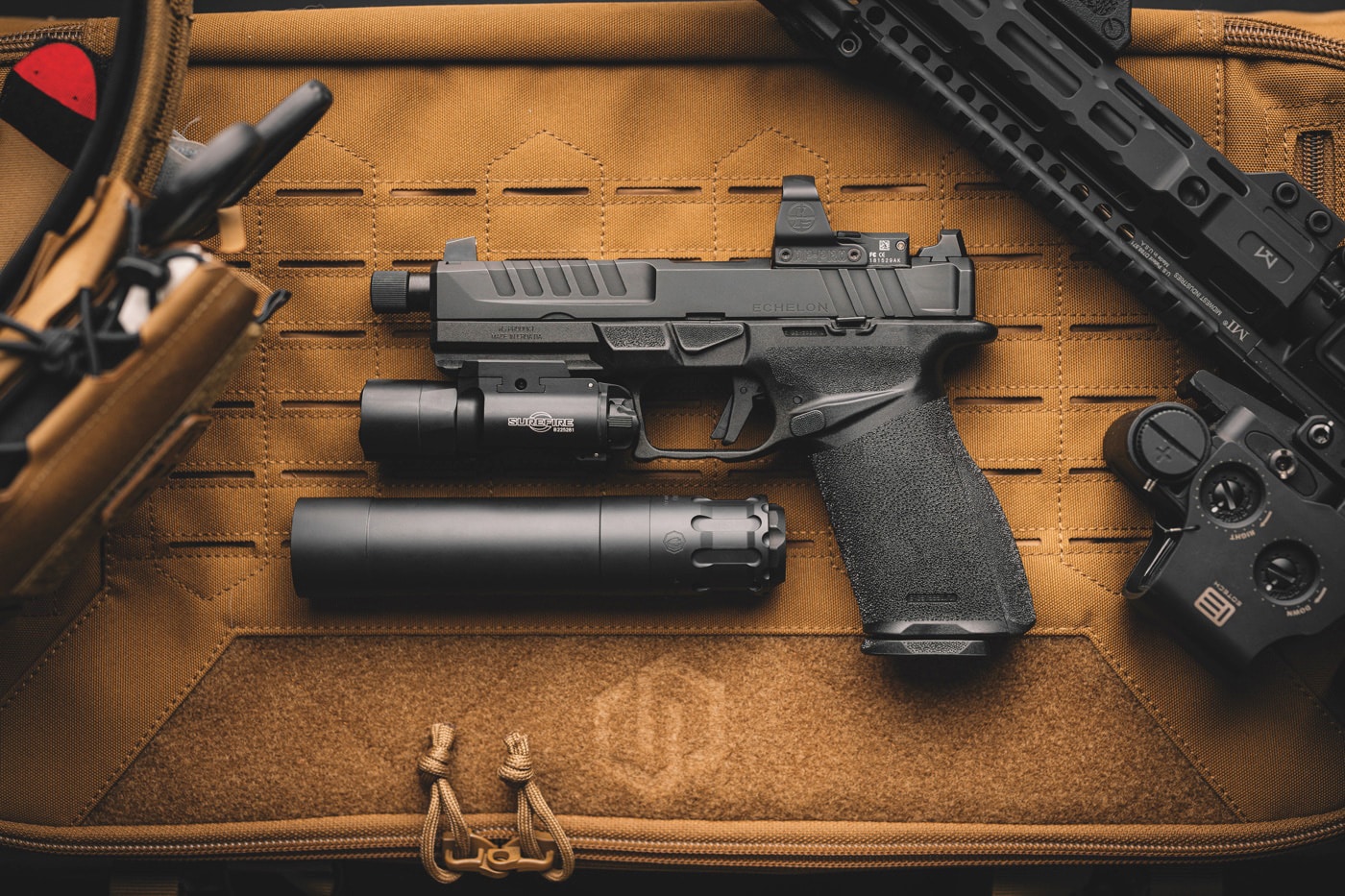
Do plate systems work? Sure. But the ideal solution for keeping an optic in place during the violent action of recoil is a direct mount between the sight and the slide using deep-seated screws and recoil lugs for added security — no extra parts or intermediate barriers. The Echelon’s innovative system offers just that. Its modular lug design and multiple attachment points allow the system to accommodate more than 30 available optics and ensure guns equipped with this system are virtually future-proof.
[Don’t miss Justin Opinion’s explanation of the Springfield Echelon optic footprint.]
In addition to solving the optic-mounting equation, the Echelon easily keeps pace in terms of capacity. Packing 17 rounds of 9mm has long been considered the standard payload for full-size, double-stack pistols. The Echelon matches that, and also offers a 20-round magazine that increases both capacity and gripping surface, thanks to its textured, extended basepad.
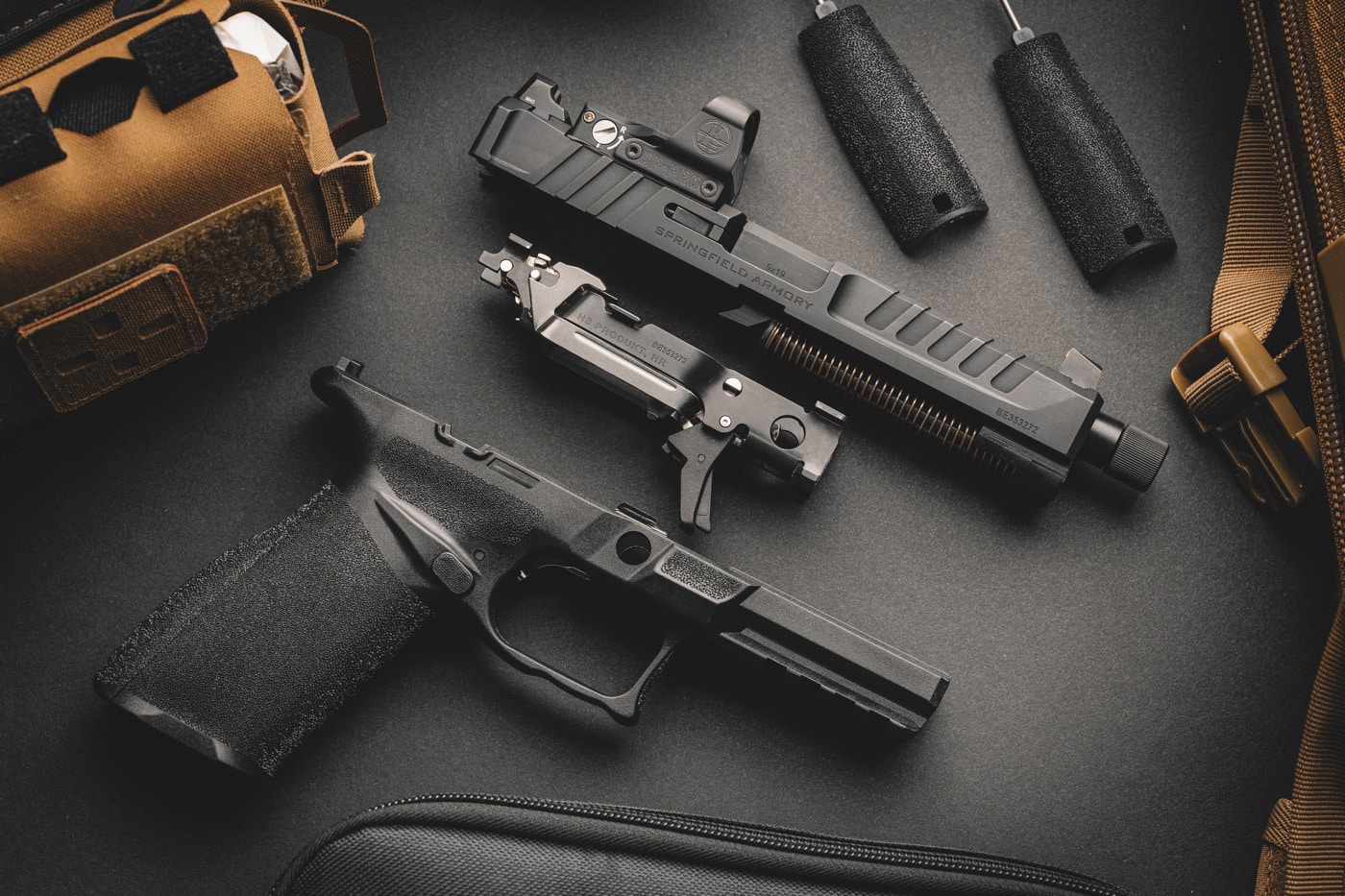
Custom fitment comes standard with the Echelon thanks to the serialized Central Operating Group and the bevy of frame adjustment options. Being that this part is the “firearm,” Springfield can offer three interchangeable grips modules. In addition, three sizes of backstraps are included with the Echelon to further refine the fit, and the backstraps will fit any of the frames.
Overall, the Echelon is a thoroughly modern pistol that offers an innovative take on optic mounting, has capable ammunition capacity, and even addresses fit and feel concerns for the increasingly diverse American handgun market. Now, the pistol takes on another growing trend. Enter the Echelon Threaded, a pistol prepared to offer more bite with less bark.
Threaded Barrel Echelon Specifications
| Chambering | 9mm |
| Barrel | 5.28″ threaded (1/2×28) |
| Weight | 24.5 oz. |
| Overall Length | 8.8″ |
| Sights | Three-dot tritium |
| Grips | Integral, polymer |
| Action | Striker-fired |
| Finish | Black |
| Capacity | 17+1, 20+1 (one magazine of each type included) |
| MSRP | $739 |
Setting Up for Success
As the name implies, the Echelon Threaded is distinct for its 5.28” barrel, compared to the standard 4.5” Echelon barrel. The added length extends beyond the slide and provides room for 1/2×28-pitch threading. The thread pattern is pretty standard for 9mm firearms, so it should be compatible with most suppressors and other muzzle devices. A knurled thread protector is also included.
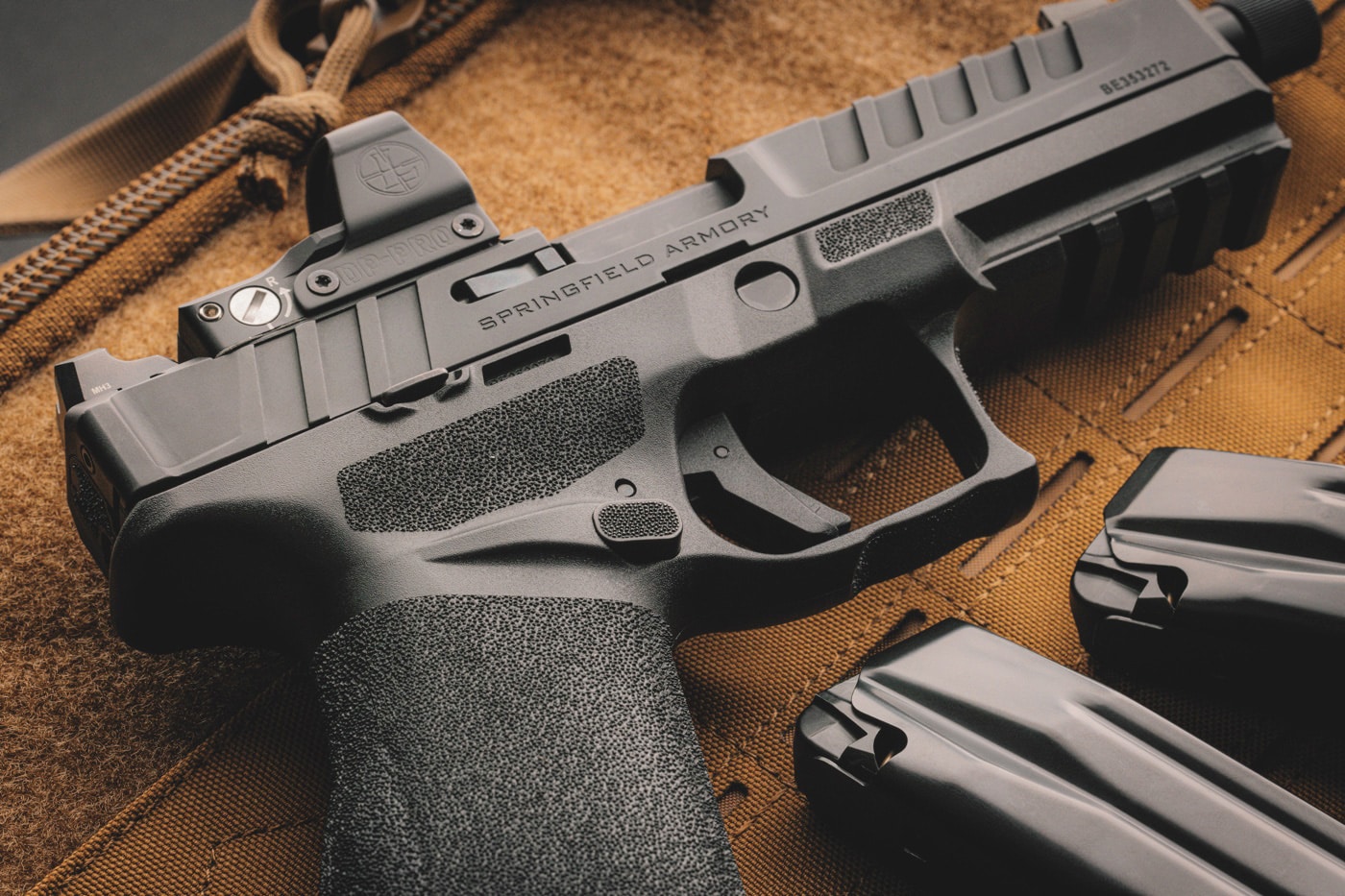
After receiving a review sample of the Echelon Threaded, the first order of business was to set the pistol up for use. I have average-size hands, so the standard medium-size grip module works perfectly for me. When it came to backstrap selection, I tested all three options. Swapping between them is very simple and just requires the internal release tab, accessed through the magazine well, to be depressed. I found that the largest backstrap provided the most engagement with my natural firing grip.
With the grip frame sized and sorted, it was time to add an optic. I opted to use a Leupold DeltaPoint Pro with a 2.5 MOA red-dot reticle. Two reasons I like Leupold’s DPP: First, it’s a proven design. It’s durable, it has a small reticle for precise shooting, and the external battery access makes maintenance a breeze. Second, considering the Echelon Threaded has the capability to accept a suppressor, I wanted to choose a red-dot sight with a slightly taller deck height. Normally, I favor low-profile optics to keep the entire firearm package as trim as possible. However, knowing I would be mounting a suppressor, I recognized that a slightly taller optic like the DPP would ensure that I could see and aim over a can.
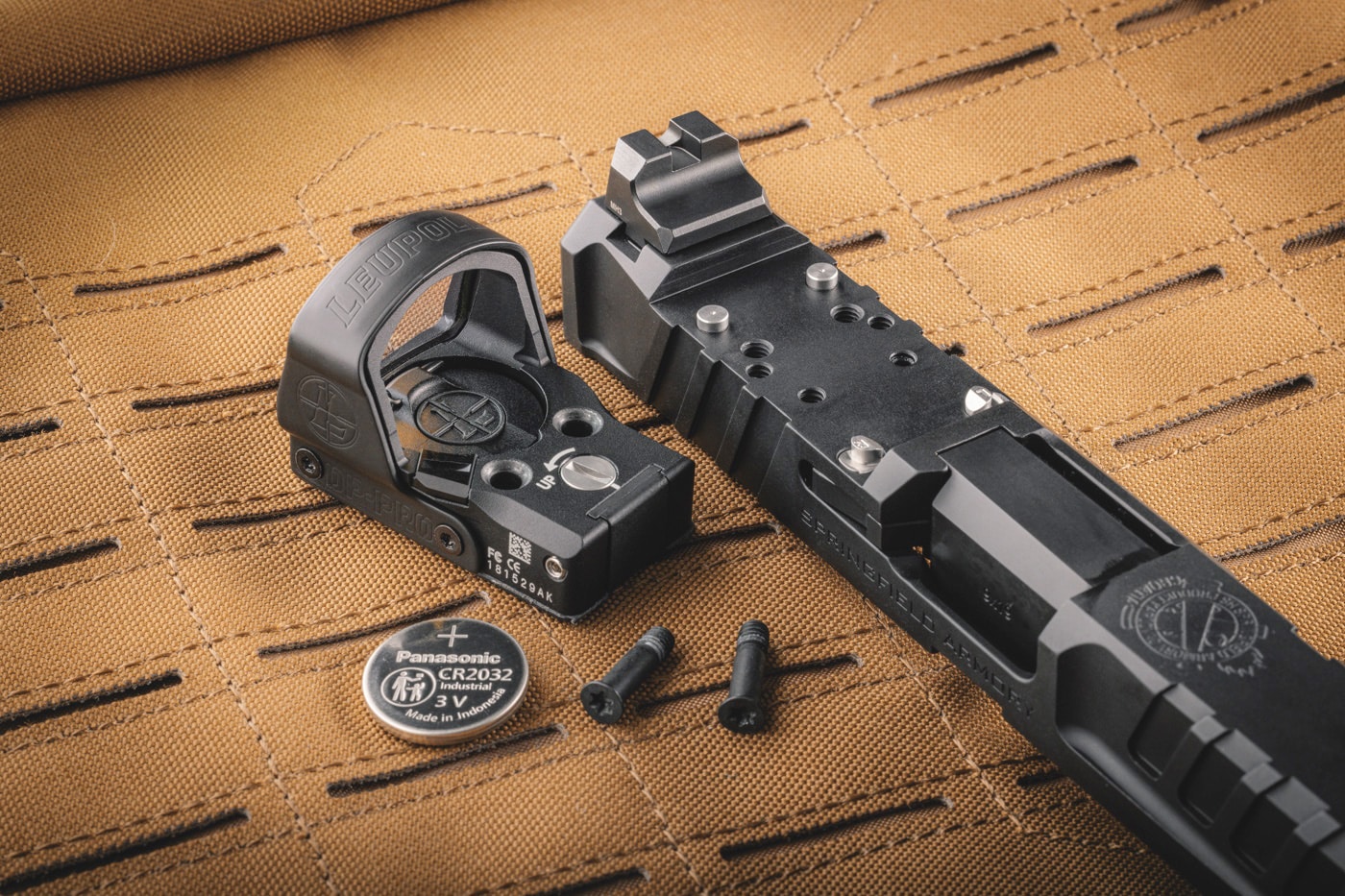
Following the instructions and diagrams in Springfield’s online Operation & Safety Manual, mounting the optic was easy. For the Leupold DPP, I used the included pin set 2 and screw set 2A. Just be sure you consult with the optic’s instruction manual for recommended torque values.
Finally, it wouldn’t be much of a test if I didn’t include a suppressor. I opted to use Silencer Central’s Banish 45, a modular .45-caliber can. Well-suited for pistol and rimfire cartridges, the Banish 45 can be run in a long 12-baffle configuration or a shorter eight-baffle setup. It is also adaptable for many firearm platforms thanks to its ability to accept a wide range of mounts and pistons. For the Echelon Threaded, I added the ½x28 piston, which would mount directly to the gun’s threaded barrel. I also opted to use the long — 8.6”, 11 oz. — configuration for maximum sound suppression.
At the Range
Ready for the range, I wanted to thoroughly test the Echelon Threaded. That meant everything from running defensive drills to bench-rested accuracy. I also wanted to know how performance would change when a suppressor was added. But before I could begin, I fired a few rounds to zero the Leupold DPP. Typically, I get a rough zero before the first shot by simply “lollipop-ing” the dot reticle over the front iron sight, then refine with feedback from three-shot groups. There is a lot of debate about what distance you should zero your red-dot at — more than enough for its own article. Since I would be conducting accuracy testing at 15 yards, per The Armory Life protocol, I set my zero at that distance.
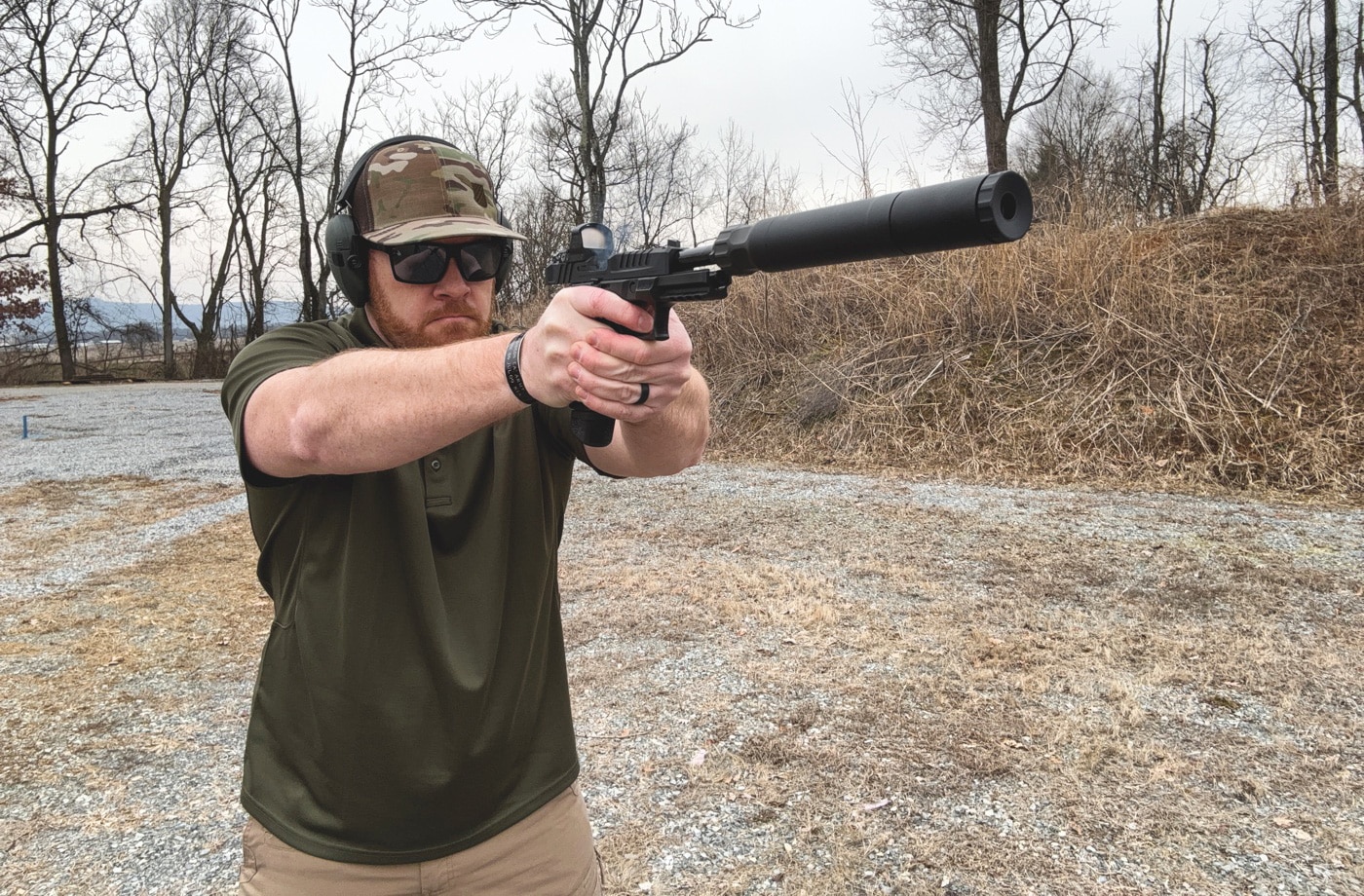
As expected, the Echelon is a beast for defensive work. Coming from the low ready or out of the holster, the gun points very naturally thanks to its ergonomic design and customizable fit. Too, the gun runs fast. I shoot so many micro pistols these days that I sometimes forget how easy it is to shoot bigger guns, and shoot them well. For the familiarization portion of my test, I rely on a can of mixed 9mm ammo with varied bullet weights and profiles. It’s the remnants from 14 years of handgun testing, and it does an excellent job of sussing out if a pistol is picky. The Echelon Threaded is not. Not at all.
For accuracy testing, I chose three loads from different makers: Hornady American Gunner 124-grain XTP; Remington UMC 124-gr. full-metal jacket (FMJ); and Winchester Defend 147-gr. jacketed hollow point (JHP). The testing standard called for three, five-shot groups from each, fired from a rest at 15 yards. Across the board, the Echelon Threaded performed admirably, and all of the loads turned in very good accuracy results. In fact, the average of all the groups combined was right at 1.5”. In my experience, 2” groups or better at 15 yards is a good expectation for a personal defense firearm with a red-dot sight, so the Echelon and DeltaPoint Pro combo beat that mark by a fair margin. Full results are tabulated nearby; note that less than two-tenths of an inch separated the individual averages.
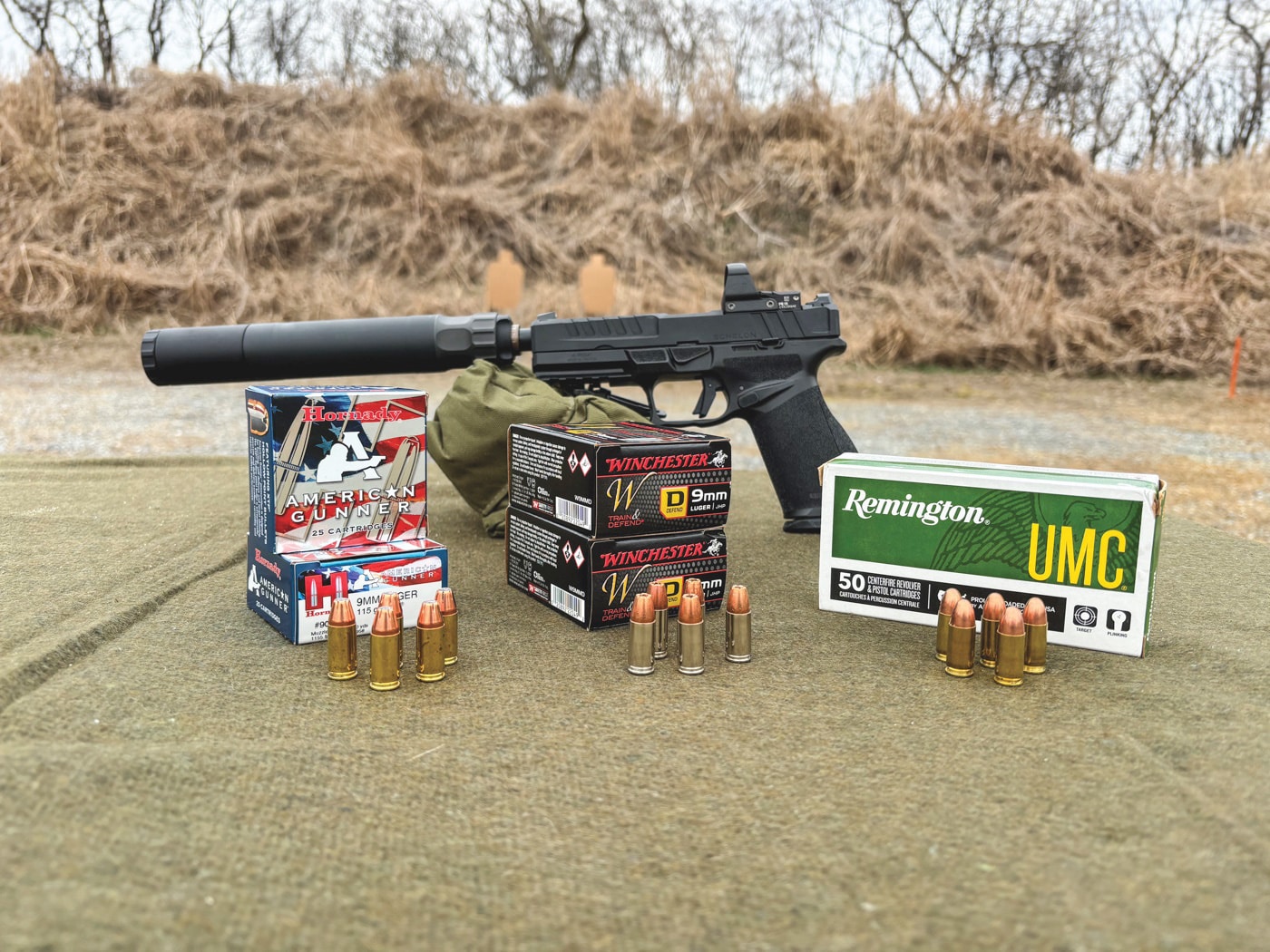
During the testing, I really came to appreciate the Echelon’s trigger. One of the benefits of a striker-fired gun is the consistency of the trigger pull. It’s not that they are short and crisp with a glass-like break, the way a good 1911 trigger can be, but they tend to be predictable and repeatable in a well-made pistol. The Echelon Threaded was that, and also very smooth, with no detectable grit or hang-ups. A total of 10 pulls with a Lyman Digital Trigger Gauge yielded an average weight of 5 lbs., 5 oz. With the clean travel it felt even lighter and was definitely an aid to accurate shooting.
Shooting Performance
| Ammunition | Velocity | Group (best) | Group (average) |
|---|---|---|---|
| Hornady American Gunner 124-gr. XTP | 1,186 fps | 1.17” | 1.42″ |
| Remington UMC 124-gr. FMJ | 1,142 fps | 1.50″ | 1.57″ |
| Winchester Defend 147-gr. JHP | 1,053 fps | 1.10″ | 1.51″ |
Running Quiet
With accuracy testing complete, I really wanted to see if there were any performance shifts when a suppressor is added. Three measures I was really watching for were impact shift, velocity changes and effects on reliability.
The first two characteristics are related, but not necessarily the same. Changes in velocity can affect the point of impact. Most commonly, we see vertical stringing when velocities increase or decrease. However, when adding a suppressor with internal baffle structures and more than 8” of extra tube, I’m also concerned that the bore alignment and directional qualities of propellant gases may be affected.
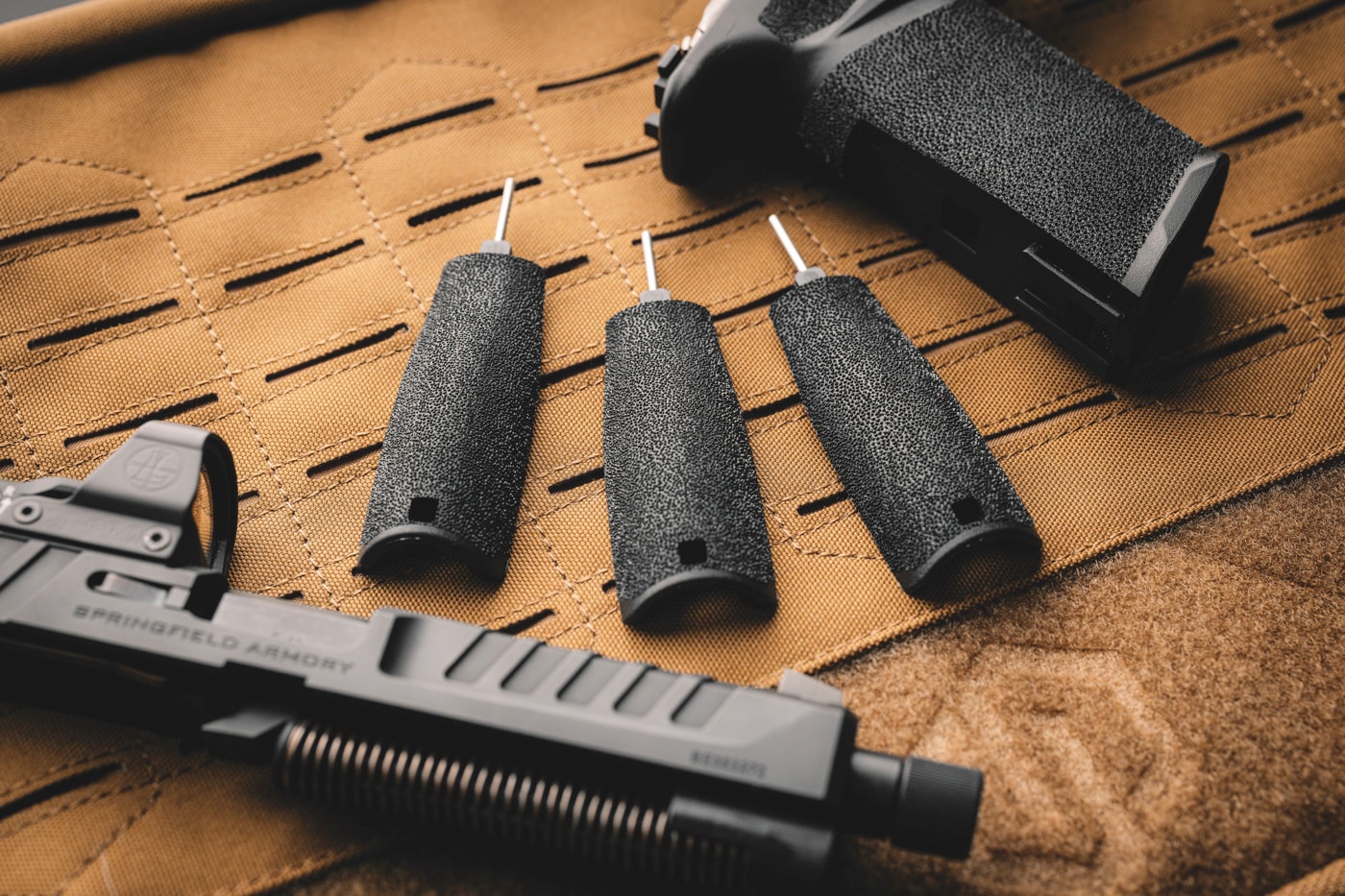
I should not have worried. Using the Winchester Defend ammo, I fired several new three-shot groups from the bench without the suppressor and numbered the impacts “1”. I then attached the Banish 45 and fired another round of groups at the same targets and labeled the impacts “2”. The groups match up nearly perfectly. Only my numbering allowed me to discern suppressed and unsuppressed shots. At 15 yards, there was no noticeable shift. Data from the chronograph further confirmed my findings. The average velocity for 10 rounds with the Banish 45 attached was 1,059 fps, only a 6-fps increase. Negligible.
For reliability testing, it was back to the can of mixed ammo. For those unfamiliar, the concern with adding a suppressor to a handgun is that the added weight of the can, even just a few ounces, will play havoc with the operation of moving parts in a semi-automatic firearm. Moreso for a tilt-barrel design. That’s why pistons have become so prevalent on pistol-caliber suppressors. The spring-loaded adaptors help mitigate the adverse effects of muzzle-mounted devices. Regardless of the ammunition used, the Echelon Threaded / Banish 45 combo worked flawlessly. Functionality was 100 percent, with energetic ejection and no failures to feed.
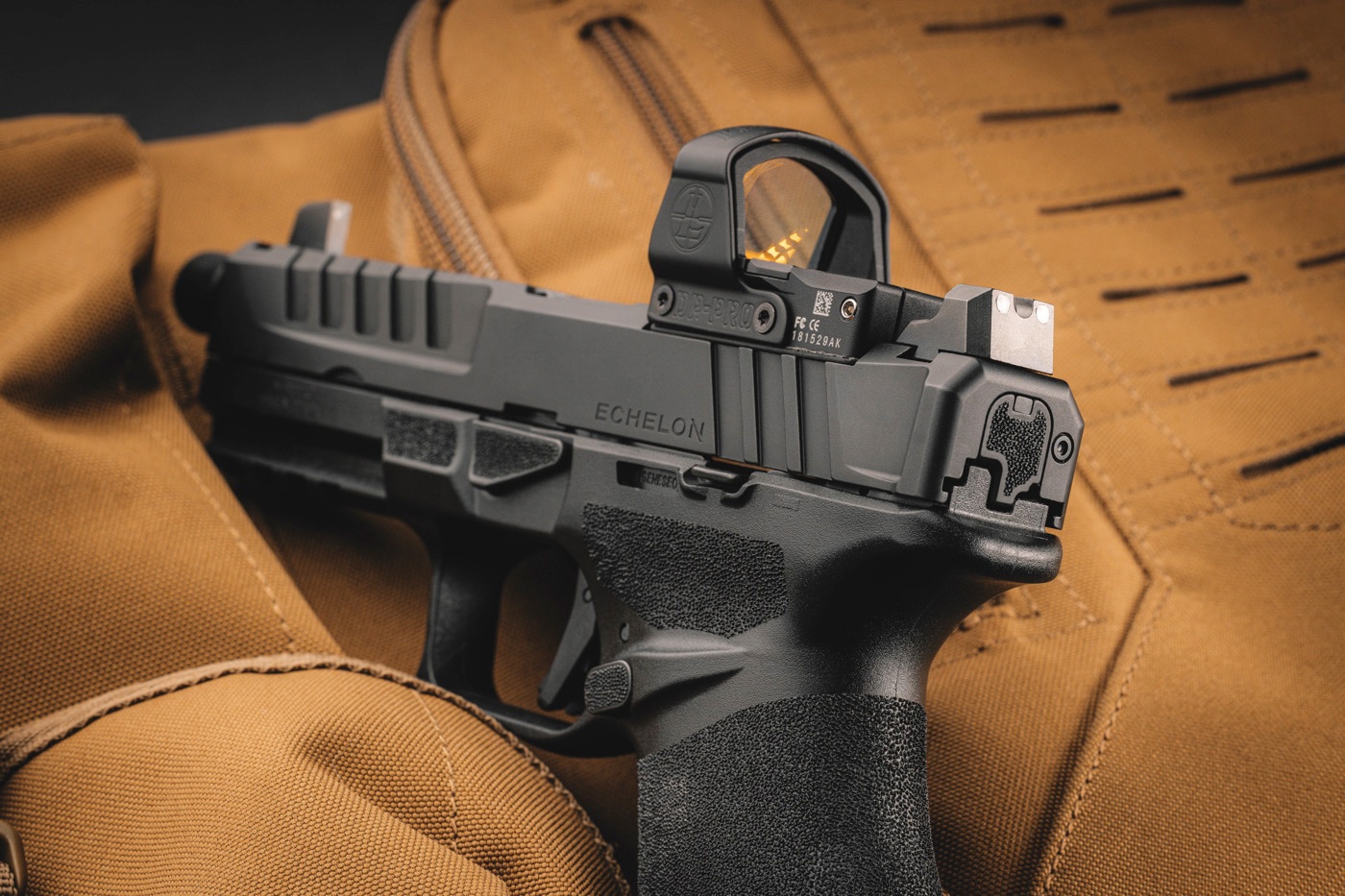
So, how did it sound? Silencer Central advertises 36 decibels of sound reduction when firing 9mm ammunition through the Banish 45. While I can’t confirm the company’s measurements, I can attest that the report was reduced to hearing-safe levels. Shooting is still loud, not like you see in the movies, but the noise is dampened and shifted forward away from the ear. I would still highly recommend wearing ear protection when shooting suppressed, but there is no doubt suppressors make any shooting experience more enjoyable.
The Final Score
Without question, the Echelon from Springfield Armory is among the most modern handgun designs extant, and it sets a new standard for optics-compatibility with the Variable Interface System. Among full-size duty-rated handguns Springfield is entering a very crowded market, but in the Echelon, I think the company has the right tool for the job.
Already an extremely capable pistol, the Echelon Threaded adds adaptability for muzzle-mounted devices such as suppressors and compensators, further future-proofing the design. If you haven’t invested in an Echelon yet, the Threaded model is your do-everything option. Alternatively, threaded barrels for standard Echelons are available in Springfield Armory’s online store. There’s no excuse not to enjoy a little peace and quiet.
Editor’s Note: Please be sure to check out The Armory Life Forum, where you can comment about our daily articles, as well as just talk guns and gear. Click the “Go To Forum Thread” link below to jump in!
Join the Discussion
Featured in this article
Continue Reading
Did you enjoy this article?

 155
155




